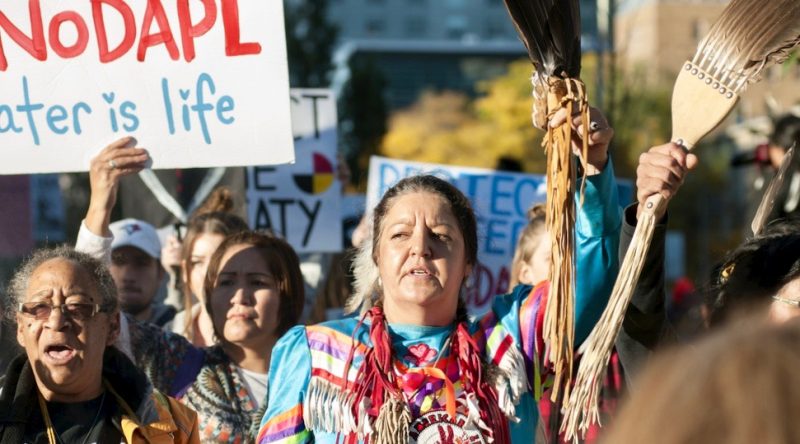Opinion: Love, Justice And Climate Change. News About Indigenous Resistance to Fossil Fuel Projects

Dakota Access Pipeline Protest. Photo: arindambanerjee.

Indigenous people’s resistance to fossil fuel projects in the United States and Canada has had a major impact. Many people are familiar with the opposition to the Dakota Access Pipeline led by the Standing Rock Sioux tribe starting in 2016 and the current struggle against the Line 3 pipeline through treaty-protected Anishinaabe land in Minnesota. Less well known are more than 20 other projects that Indigenous people have organized to fight. Some of these fights they have won, some are ongoing, and a few have been lost.
New Report Measures Impact Of Indigenous Resistance
A new report has calculated that Indigenous resistance has stopped or delayed 1.587 billion tons of carbon emissions in the last 10 years through highly effective campaigns. This is an amount equivalent to the pollution of approximately 400 new coal-fired power plants, or roughly 345 million passenger vehicles (more than all the vehicles on the road in the U.S. and Canada). It is also equivalent to 24% of one year’s total carbon emissions in the U.S. and Canada combined.
The report, titled “Indigenous Resistance Against Carbon” was released in late August by the Indigenous Environmental Network, “an alliance of Indigenous Peoples whose Shared Mission is to Protect the Sacredness of Earth Mother from contamination and exploitation by Respecting and Adhering to Indigenous Knowledge and Natural Law” and Oil Change International, “a research, communications, and advocacy organization focused on exposing the true costs of fossil fuels and facilitating the ongoing transition towards clean energy.”
The report lifts up the work of Indigenous people who have dedicated their lives to “defending the sacredness of Mother Earth and protecting their inherent rights of Indigenous sovereignty and self determination.” It explains that their campaigns against these fossil fuel projects have blended non-violent direct action, political lobbying, multimedia, divestment, and other tactics.
Indigenous Rights
These struggles are about the threatened damage to the environment and the worsening of climate change, but equally about defending Indigenous rights. Many of these fossil fuel projects have violated previously agreed to treaty rights. Most, if not all, have violated “Free, Prior and Informed Consent” (FPIC) which is a right recognized in the United Nations Declaration on the Rights of Indigenous Peoples. It allows Indigenous Peoples to give or withhold consent to a project that may affect them or their territories. Indigenous rights have consistently been trampled as fossil fuel companies put extraction and profits ahead of Indigenous rights, ahead of protecting water sources, and ahead of the need to stop disastrous climate change.
Spiritual Dimension
I know from talking to people who have been at the Standing Rock or Line 3 actions, as well as from this report, that these actions also have a spiritual dimension that has been quite moving for non-native allies as well as for Indigenous people. This report describes the actions as carrying out spiritually- and culturally-derived obligations to preserve inherent relationships to the natural world, to recognize the “natural laws of Mother Earth and Father Sky, and to protect future generations.” These values are leading many Indigenous people to fight to keep fossil fuels in the ground.
What About Those Of Us Who Are Non-Native People?
All of us are descended from people who were originally indigenous to the places they lived. If we go back far enough, we must all have ancestors who had a spiritual connection to the land they called home, who felt an obligation to protect and preserve the natural world, and who felt an obligation to future generations. Perhaps it is not too late for us to follow the lead of the Indigenous people of North America and personally reclaim these connections to land, water, sky, each other, and future generations.
Other Notes – North America
Indigenous people have lived on the land in North America for at least 15,000 years. There were probably about 10 million Indigenous people living in what is now the U.S. when Columbus voyaged to North America in 1492. A combination of deadly disease epidemics and genocidal warfare conducted by the White settler government left a native population in the U.S. of less than 250,000 in 1890. In the 2020 census, 9.7 million people identified as native or native in combination with one or more other races. This is about roughly 2.9% of the U.S. population.
Indigenous Protection Of Land And Forests Worldwide
Throughout the world, Indigenous people have secure land tenure on 18% of all land area and live on and manage much more, including about 1.2 billion acres of forest. Indigenous communities worldwide have been resisting deforestation, oil and gas extraction, and the expansion of monoculture plantations for more than two centuries. Many of their traditional practices in agriculture and forest management, often considered unsophisticated and inefficient, are proving to have superior yields while sequestering more carbon than “modern” factory farm methods. As a result, Indigenous communities are playing a significant role in mitigating global warming.
Despite the reduction in forests globally, there has been some increase in the secure tenure of forestlands by Indigenous people. The climate benefits of Indigenous land tenure are so significant that the Drawdown Project lists further increasing the number of acres of forest under secure Indigenous tenure as one of its top 30 solutions to the climate crisis. This will both protect Indigenous people’s rights and prevent between 9 and 13 gigatons of carbon dioxide emissions between now and 2050 through reduced deforestation.
Next Steps
It makes sense for all of us to back Indigenous climate efforts, follow Indigenous leadership and thinking, and learn from their traditional knowledge, wisdom, and effectiveness. The water protectors at Line 3 in Minnesota are inviting allies to “Come to the Line” and “Stop the Line 3 Pipeline: For Water. For Treaties. For Climate.” You might consider joining them. Building relationships with Indigenous people, either near you or at Line 3, can help you learn to think outside the profit-driven extractive mentality of the dominant society. More information and donation opportunities are available at the Indigenous Environmental Network and Honor the Earth.
Russ Vernon-Jones was the Principal of Fort River Elementary School from 1990 to 2008. He is a co-facilitator of the Coming Together Anti-Racism Project in the Amherst area. He chairs the Racism, White Supremacy, and Climate Justice working group of Climate Action Now of Western Mass., and blogs regularly on climate justice at www.RussVernonJones.org.
